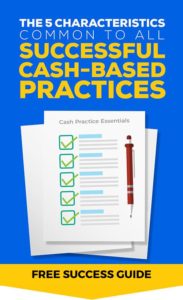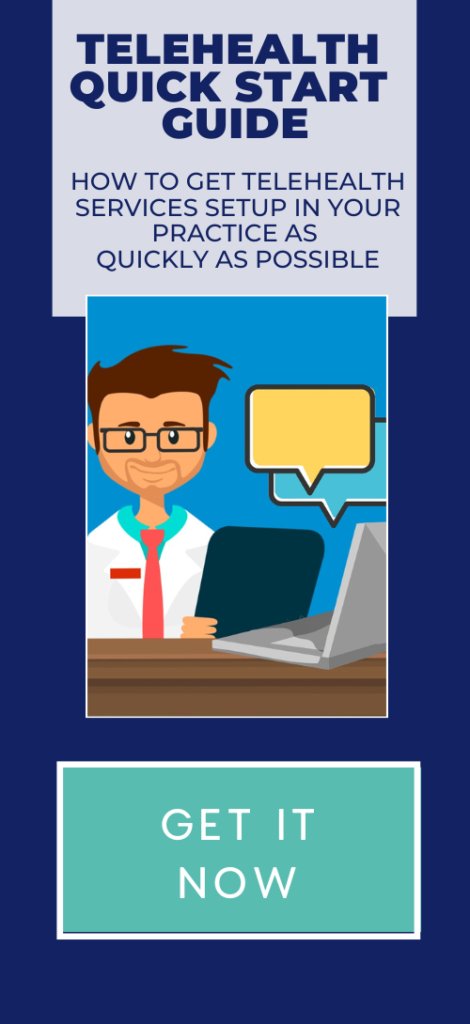 A common question and concern I hear from prospective cash-based practice owners was summed up nicely in an email I recently received:
A common question and concern I hear from prospective cash-based practice owners was summed up nicely in an email I recently received:
One of my biggest obstacles to getting started is figuring out how much cash I need to open my doors? Did you have a set amount when you started, and how did you come up w/that figure?
Here was my answer:
When I started my practice, I only had a few months of living expenses in savings, which essentially meant I had almost no start-up capital for my business. I didn’t want to take a loan if I didn’t have to, so I didn’t spend anything I didn’t absolutely have to. Starting a business with no capital is not something I recommend, but I didn’t know any better and just did whatever it took to make it work.
I think that a big part of the answer to your question is dependent on the supplies and equipment you feel are vital to the way you treat patients. My treatments are almost all manual (and I send them home with their HEP), so all I needed was a portable massage table and a few inexpensive supplies like theraband and lacrosse balls.
I drove to patients’ homes at first, and after a while I rented a treatment room on a per/hour basis, so I wasn’t spending “rent” money unless I was making treatment money.
I spent about $60 for a year of webhosting and $10 on a url, and used a free WordPress template to set up my website and start blogging (all of this is explained in detail in my Cash Practice Guidebook). So I was essentially profitable right away, and got started with minimal capital.
Estimating startup budget
If your situation is different and you need expensive equipment that also necessitates a larger space and a lease, then the calculation of a starting budget becomes much more important. Here is what I would do in general:
1) Calculate the square footage you think you would need in a start-up office space, and do some online research or ask a commercial real estate agent the going rate/sq-foot in order to get an idea of your up-front rent costs.
Some office space will advertise a “per sq ft” cost but also have “triple net” and other costs that add on, so make sure you are clear on total overall costs. Also ask what the standard is in your area, in terms of security deposits and any other up-front fees you can expect to get into an office.
Check to see if utilities and internet are included in rent, and if not, add these costs to your calculations.
2) Do some research on the equipment you need and price each out (along with delivery fees, taxes, maintenance, etc).
3) If you know you’d rather spend a few hundred dollars to get a website designed (rather than doing it yourself), account for this and find a cheap but good web designer on Upwork.com (but be warned, it’s easy for freelancers to promise the world and then under-deliver, and it’s often “cheaper” to pay more up front to get it done right).
So if you have a bit of capital and want to start out with a beautiful website, preloaded with SEO-friendly content, and powerful lead-generation marketing components (as well as done-for-you email newsletters and Social Media marketing), I’d highly recommend connecting with the guys at PatientSites.com. Tell ’em I sent you and you’ll get a huge discount on your set-up fee.
4) Similarly, you can get 250 Free business cards on Vistaprint, but these are very basic and if you want more control of the design, you’ll need to spend more… you can still use one of their templates and keep it really cheap.
If you want to start out with a nice logo, account at least $350 for the design and I would suggest using 99designs.com unless you have someone who can do a good job for a comparable price. If you’re really on a shoestring budget, you can also try Fiverr.com to get a logo designed. I’ve had both good luck and bad luck on Fiverr but here and there you can get some pretty awesome work fro very cheap.
5) Get the costs to register your practice with your State Board and acquire liability insurance, etc.
6) If you’re going to start out with any administrative or other employees, this will also be a huge consideration, and likely a decent percentage of your starting/ongoing costs.
7) Add 10-15% to the total from above to account for unexpected expenses. There will always be unexpected expenses.
This should give you a rough starting estimate, because I wouldn’t suggest paying for any advertising up front. Going to networking events, blogging, doing presentations for personal trainers and running/cycling/crossfit groups, etc are all free and likely much more effective than paid ads in local publications, etc.
Again, much more detail on all the above steps is provided in detail in the ebook My Cash-Based Practice.
So now I pass the mic to my readers… is there anything I haven’t mentioned above that you feel should be considered when calculating start-up costs (for a cash-based practice)? Please share your knowledge!
Interested in the cash-based private practice model?
Click Here to learn how to start your own Cash-Based Practice






Jarod,
I appreciate so much your theme of being debt-free during this process. In my experience, this has been key to my practice being financially sound in its 12 years of existence. After accepting insurance for 10 1/2 years, I began an all cash practice a year and 1/2 ago. I have vowed to always make it work without borrowing, and without taking out a line of credit (recommended early on by my accountant, as if that is standard practice! I have since changed CPA’s)! There are so many creative ways to avoid debt- buying used equipment, and ways you spoke of in your article. Thank you for bringing up this subject.
Thanks for the comment, and congratulations on converting to a cash practice! I’d love to interview you about that process and how you made it all happen (especially without going into debt like described in this post… always nice to have other examples of debt-free cash based practices. I know there are many out there)
Jarod:
I emailed you via your contact email. It would be great to talk to you!
Holly
Great information. I started my cash based business 2 1/2 yrs ago as a mobile service. I now have a permanent location, but I still make house calls some. I kept my costs very low and only purchased equipment when I knew I had to have it for clients. Don’t waste money on a lot of advertising in the beginning….I’ve grown my business on word of mouth…..it’s not easy, but consumers are learning the differences in the level of service with cash based practices. I would even say bank on 20-25% for unknown expenses that come up. Some states will have costs for registering as an LLC or s-corp, which I would recommend over the sole proprietor setup. I would also recommend bootstrapping your business and not taking out loans, but that’s just me!
Thanks Missy! I forgot to add the cost of forming a legal entity for your business. Good catch.
Congrats on your success!
I am just at the beginning of this process and am looking into the legal entity options. Do you have an opinion on the most common/best way to go?
Thanks for this great information on cash based start up costs! What type of business insurance did you choose to cover any physical damage to your clinic or accidental injury to Pt from equipment, etc., once you had a physical location for your clinic? I’m sure it will vary by state, but what is the estimated cost you pay per mos or annually for this insurance?
Hey Jarod,
What on your thoughts on general liability insurance if someone was to be first starting out? Do you think it’s necessary and did you have it when you first started?